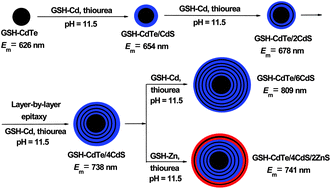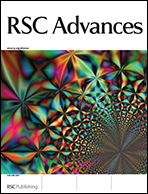Layer-by-layer aqueous synthesis, characterization and fluorescence properties of type-II CdTe/CdS core/shell quantum dots with near-infrared emission†
Abstract
A layer-by-layer epitaxial method was developed to synthesize water-soluble, near-infrared (NIR)-emitting type-II core/shell CdTe/CdS quantum dots (QDs) via employing glutathione-capped CdTe QDs as core templates, CdCl2 and thiourea as shell precursors. CdTe/CdS type-II nanostructure yields the QDs with NIR emission by varying the size of CdTe cores and the thickness of CdS shells. Compared to CdTe core QDs, CdTe/CdS core/shell QDs exhibit remarkable red-shifted spectra, and the corresponding emission maximum wavelength can span from 626 to 809 nm. Surface passivation of ZnS shell with a substantially wide bandgap restrains the excitons within CdTe/CdS QDs interface and isolates them from aqueous solution. This passivation therefore improves the photoluminescence (PL) efficiency of the CdTe/CdS nanostructure, including PL quantum yield, lifetime and photo-stability/catalytic activity. Through comprehensive research on their core/shell nanostructures, the CdTe/CdS QDs obtained from hydrothermal shell-coating route, show good monodispersity, lattice-mismatched heterostructure and NIR-emission properties, offering a great potential for biological or biomedical applications.


 Please wait while we load your content...
Please wait while we load your content...